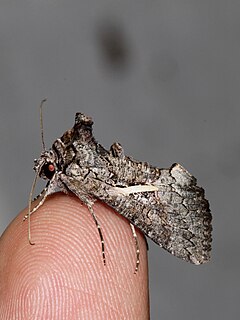
Springhill mining disaster may refer to any of three Canadian mining disasters that occurred in 1891, 1956, and 1958 in different mines within the Springhill coalfield, near the town of Springhill in Cumberland County, Nova Scotia.

Rondebosch is one of the Southern Suburbs of Cape Town, South Africa. It is primarily a residential suburb, with shopping and business districts as well as the main campus of the University of Cape Town.

The mottled beauty is a moth of the family Geometridae. The species was first described by Carl Linnaeus in his 1758 10th edition of Systema Naturae.

The de Havilland DH.80A Puss Moth is a British three-seater high-wing monoplane aeroplane designed and built by the de Havilland Aircraft Company between 1929 and 1933. It flew at a speed approaching 124 mph (200 km/h), making it one of the highest-performance private aircraft of its era.

New Waterford is an urban community in the Cape Breton Regional Municipality of Nova Scotia, Canada.

The brindled beauty is a Palearctic moth belonging to the family Geometridae.

The Sprawler(Asteroscopus sphinx) is a moth of the family Noctuoidea. It is found throughout western Europe, but is mainly a Northern species occurring South to Northern Spain the southern edge of the Alps, Central Italy and Northern Greece. North to southern Sweden. East to Kaliningrad and Moscow. Also in Central Europe, Turkey, the Caucasus and Asia Minor.

Mormo maura, the old lady or black underwing, is a species of moth of the family Noctuidae. The species was first described by Carl Linnaeus in the 10th edition of his Systema Naturae. It is found in the Palearctic realm, from north-western Africa through all over southern Europe. It reaches its northern border in the west in northern Ireland and central Scotland, in central Europe, in northern Germany and Poland. In some Nordic countries, there are single finds. The other occurrence areas include Turkestan, Anatolia, the Middle East and Iraq. The name "old lady" refers to the fact that the wing pattern was said to resemble the shawls worn by elderly Victorian ladies.

Fissipunctia ypsillon, the dingy shears, is a species of moth of the family Noctuidae. It is found in the Palearctic realm.

Achlya flavicornis, the yellow horned, is a moth of the family Drepanidae. The species was first described by Carl Linnaeus in his 1758 10th edition of Systema Naturae. It is found from Europe to the eastern Palearctic ecozone.
The South African Open – formerly known as the South African Championships, and for sponsorship reasons the Altech NCR South African Open and the Panasonic South African Open – is a defunct Grand Prix Tennis Tour, World Championship Series, ATP Tour and Virginia Slims Circuit affiliated tennis tournament played from 1891 to 2011 in South Africa. It was part of the pre-open era international seasonal tours from 1891 to 1967 from 1968 to 1971, part of the open era independent events tour from 1972, when it became part the men's Grand Prix Tour until 1989. The women's side of the competition was only briefly part of Virginia Slims tour (1970–74) before it returned to the independent circuit.

Chortodes fluxa, the mere wainscot, is a moth of the family Noctuidae. The species was first described by Jacob Hübner in 1809. It is found in Europe and east across the Palearctic to Siberia, Mongolia, and northern China. Also in northern Turkey and the Caucasus.

Hippotion roseipennis is a moth of the family Sphingidae. It is known from dry areas from KwaZulu-Natal and Mozambique to Zimbabwe, Zambia, Malawi, Tanzania, Kenya, Uganda and south-western Ethiopia.

Macroglossum trochilus, the African hummingbird hawk-moth, is a moth of the family Sphingidae. The species was first described by Jacob Hübner in 1823. It is very common in most habitats throughout southern and eastern Africa and in the Comoro Islands.

Ctenoplusia accentifera is a moth of the family Noctuidae. It is found in South-Western Europe, Greece, Africa, the Near East and Asia Minor.

Apamea zeta is a moth of the family Noctuidae. It has a Holarctic distribution, and can be found throughout the Northern Hemisphere. It occurs throughout Europe and the northern half of North America.

The double-spot brocade is a species of moth of the family Noctuidae. It is found in most of Europe, in Turkey and the west of Iran. In Anatolia it is represented by the subspecies Meganephria bimaculosa pontica.
Paraplatyptilia carolina is a moth of the family Pterophoridae described by William D. Kearfott in 1907. It is found in the southeastern United States, including Florida, southern Mississippi, North Carolina and Georgia.
Dichomeris piperatus is a moth in the family Gelechiidae. It was described by Walsingham in 1892. It is found in the West Indies, where it has been recorded from St. Vincent, Puerto Rico and Cuba.















